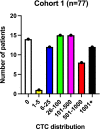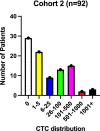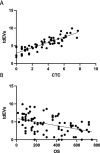Coagulation/fibrinolysis and circulating tumor cells in patients with advanced breast cancer
- PMID: 35132503
- PMCID: PMC8960658
- DOI: 10.1007/s10549-021-06484-1
Coagulation/fibrinolysis and circulating tumor cells in patients with advanced breast cancer
Abstract
Purpose: To evaluate the relationship between circulating tumor cells (CTCs) and standard coagulation tests in both a discovery and a validation cohort of patients with advanced breast cancer.
Methods: In a retrospective (n = 77) and a prospective (n = 92) study of patients with progressive advanced breast cancer, CTC count, platelet number, fibrinogen level, D-dimers, prothrombin time, and activated partial thromboplastin time were measured. The association between these coagulation studies and CTC count was analyzed. The impact of these measurements on overall survival (OS) was assessed.
Results: In both cohorts, results were similar; absolute CTC count was significantly associated to D-dimer level and inversely with platelet count. In the prospective cohort, quantification of tumor-derived extracellular vesicles (tdEVs) was associated with CTC count, and with coagulation abnormalities (low platelet count and increased D-dimers). tdEVs did not add to CTC count in predicting changes in platelets or D-dimers. In multivariate analysis only CTC ≥ 5 CTC/7.5 mL, ER status, HER2 status and lines of chemotherapy were associated with OS. In patients with terminally metastatic breast cancer, very high CTC counts are prevalent.
Conclusion: A significant association exists between increasing CTC number and increased D-dimers and decreased platelet counts, suggesting a potential role for CTCs as a direct contributor of intravascular coagulation activation. In patients with advanced and progressive breast cancer, abnormalities in routine coagulation tests is the rule. In patients with terminally advanced breast cancer a "leukemic" phase with high CTC count is prevalent.
Keywords: Advanced breast cancer; Circulating tumor cells; D-dimers; Diffuse intravascular coagulation; Platelets; Tumor derived extracellular vesicles.
© 2022. The Author(s).
Conflict of interest statement
The authors declare that they have no conflict of interest.
Figures





Similar articles
-
HER2 expression on tumor-derived extracellular vesicles and circulating tumor cells in metastatic breast cancer.Breast Cancer Res. 2020 Aug 12;22(1):86. doi: 10.1186/s13058-020-01323-5. Breast Cancer Res. 2020. PMID: 32787900 Free PMC article.
-
Circulating tumor cells as a prognostic marker for efficacy in the randomized phase III JO21095 trial in Japanese patients with HER2-negative metastatic breast cancer.Breast Cancer Res Treat. 2017 Apr;162(3):501-510. doi: 10.1007/s10549-017-4138-3. Epub 2017 Feb 8. Breast Cancer Res Treat. 2017. PMID: 28181129
-
Clinical significance of circulating tumor cells (CTCs) with respect to optimal cut-off value and tumor markers in advanced/metastatic breast cancer.Breast Cancer. 2016 Jan;23(1):120-127. doi: 10.1007/s12282-014-0539-x. Epub 2014 Jun 7. Breast Cancer. 2016. PMID: 24906662
-
Clinical application of circulating tumor cells in breast cancer: overview of the current interventional trials.Cancer Metastasis Rev. 2013 Jun;32(1-2):179-88. doi: 10.1007/s10555-012-9398-0. Cancer Metastasis Rev. 2013. PMID: 23129208 Free PMC article. Review.
-
Circulating Tumor Cells: Does Ion Transport Contribute to Intravascular Survival, Adhesion, Extravasation, and Metastatic Organotropism?Rev Physiol Biochem Pharmacol. 2022;182:139-175. doi: 10.1007/112_2021_68. Rev Physiol Biochem Pharmacol. 2022. PMID: 35137308 Review.
Cited by
-
Effectiveness of D-dimer in predicting distant metastasis in colorectal cancer.PLoS One. 2024 Jul 12;19(7):e0306909. doi: 10.1371/journal.pone.0306909. eCollection 2024. PLoS One. 2024. PMID: 38995895 Free PMC article.
-
A novel classifier combining G protein-coupled receptors and the tumor microenvironment is associated with survival status in glioblastoma.Front Pharmacol. 2023 Jul 25;14:1093263. doi: 10.3389/fphar.2023.1093263. eCollection 2023. Front Pharmacol. 2023. PMID: 37560473 Free PMC article.
-
A new prognostic model for glioblastoma multiforme based on coagulation-related genes.Transl Cancer Res. 2023 Oct 31;12(10):2898-2910. doi: 10.21037/tcr-23-322. Epub 2023 Oct 10. Transl Cancer Res. 2023. PMID: 37969372 Free PMC article.
-
A coagulation-related long non-coding RNA signature to predict prognosis and immune features of breast cancer.Discov Oncol. 2025 May 3;16(1):662. doi: 10.1007/s12672-025-02316-6. Discov Oncol. 2025. PMID: 40317354 Free PMC article.
-
Neutrophil Extracellular Traps Enhance Procoagulant Activity and Predict Poor Prognosis in Patients With Metastatic Breast Cancer.Int J Gen Med. 2025 Mar 4;18:1247-1259. doi: 10.2147/IJGM.S511024. eCollection 2025. Int J Gen Med. 2025. PMID: 40062357 Free PMC article.
References
MeSH terms
Substances
LinkOut - more resources
Full Text Sources
Medical
Research Materials
Miscellaneous

